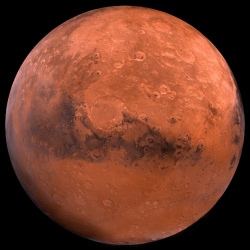
Mars is regarded as the most Earth-like of the planets in the Solar System, but its atmosphere is only 0.6 percent as dense as Earth’s and is constantly leaking into space. NASA’S Mars Atmosphere and Volatile Evolution (MAVEN) Mars orbiter is providing new insights into the loss of the Martian atmosphere by discovering how solar winds penetrate to surprisingly low altitudes.
Blessed with its powerful magnetic field, the Earth’s atmosphere is protected from the constant blast of light, radiation, and subatomic particles emitted from the Sun. Mars however, is not so fortunate. What little magnetic field it has is extremely weak and patchy, and as the solar winds strike the upper reaches of the atmosphere, they strip it away atom by atom. How this process works is one of the key mysteries for scientists studying the planet.
NASA says that the MAVEN spacecraft, which is tasked with making a detailed study of the Martian atmosphere, has discovered a new process that demonstrates just how deep the impact of the solar wind is on the air around Mars. The unmanned orbiter’s Suprathermal and Thermal Ion Composition (STATIC) instrument found a plume of ionized gas rising from the poles of Mars into the tenuous layer of ions and electrons, called the ionosphere, that ranges from 75 to 300 mi (120 to 480 km) above the surface, and was able to measure its temperature. As it orbits, MAVEN’s lowest altitude dips into the ionosphere, allowing it to directly measure its temperature and composition.
